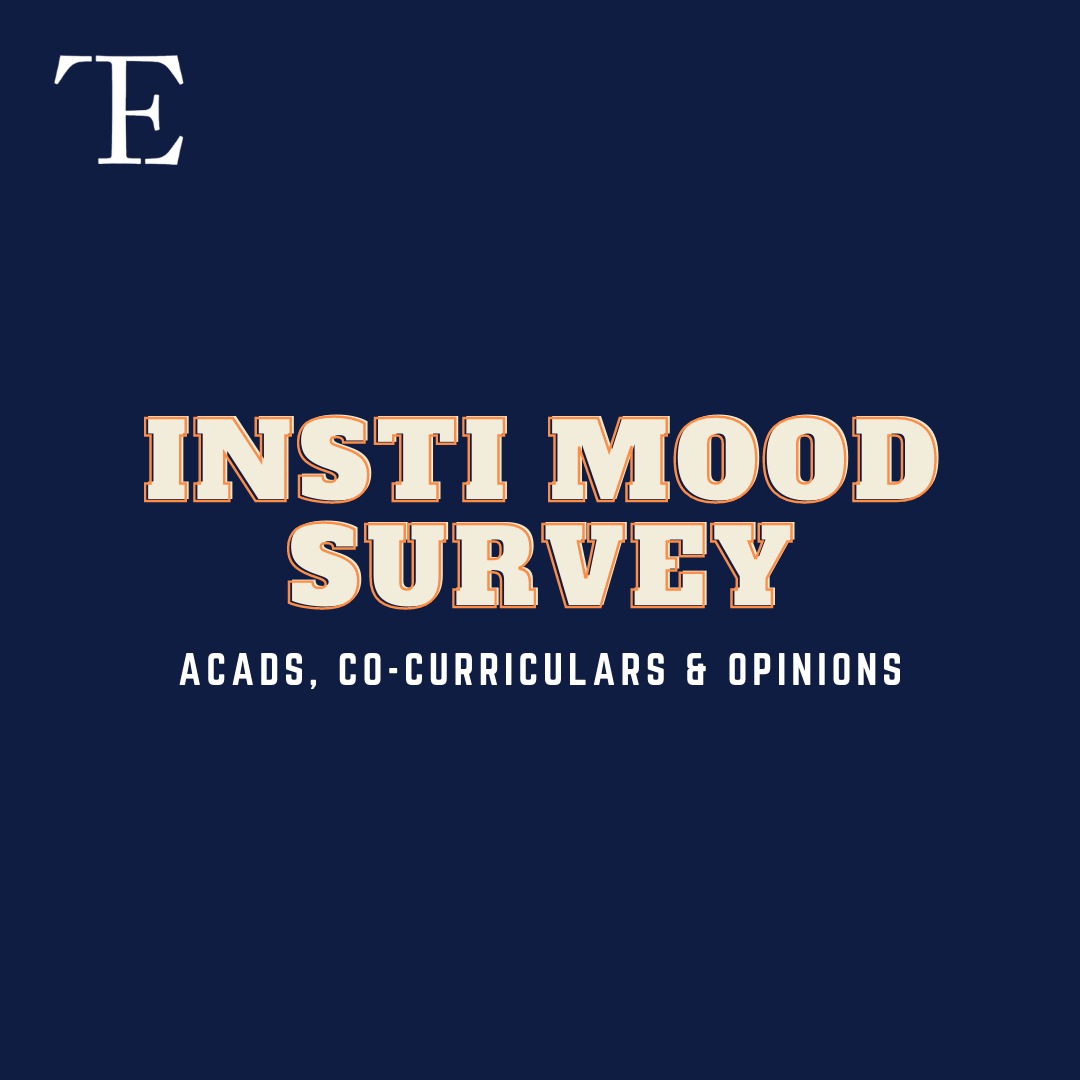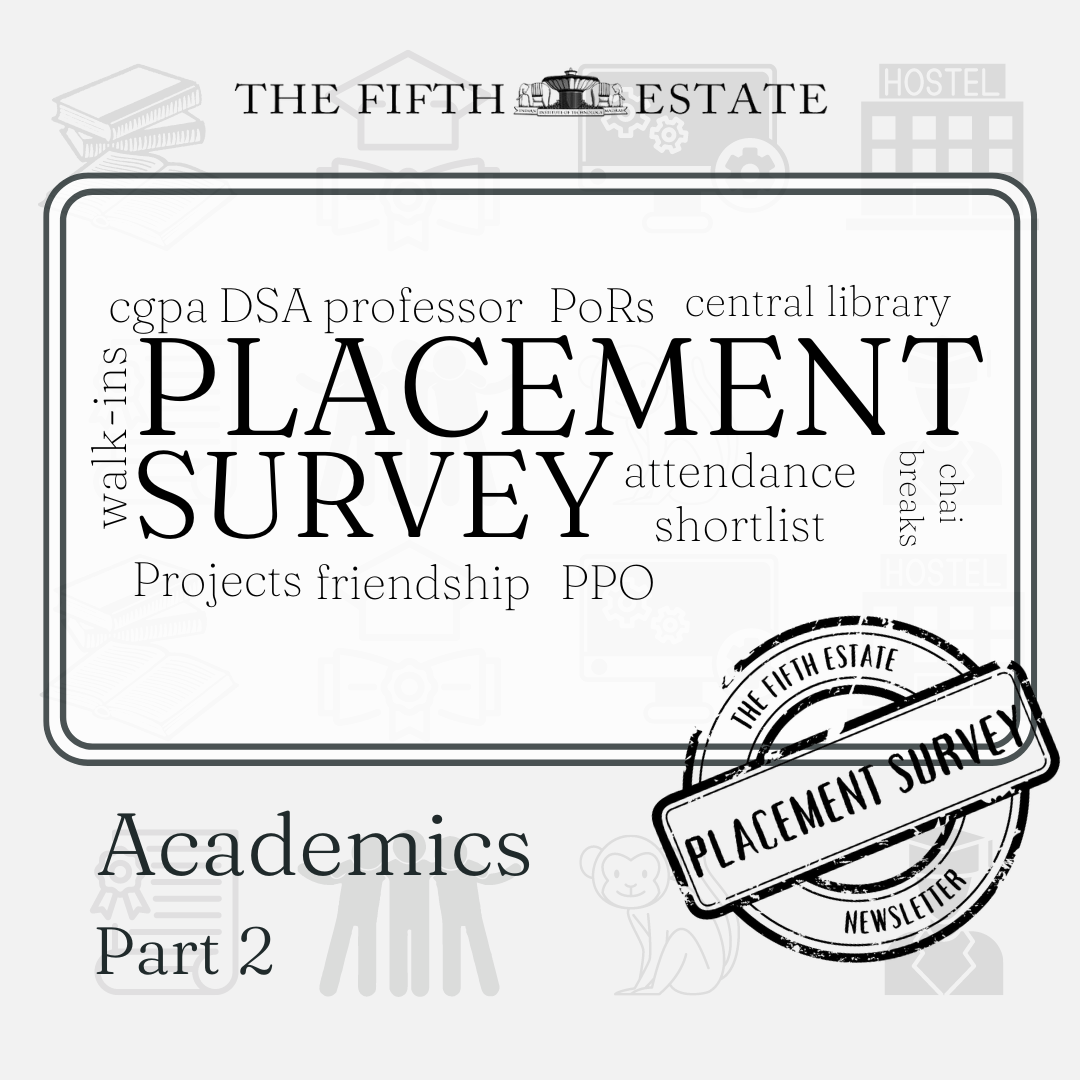Note: T5E’s Insti Mood Survey 2021 was conducted in September to study the current lived reality of institute students. The survey received a total of 1306 responses with sizable (albeit skewed) representation from all degrees and batches.
The aspects studied by the survey are Academics, Co-Curriculars, Opinion, Mental Health, Physical Health and Time and At-home-life.
This article delves into the first three aspects.
1. Demographics
Before you read the article, take a close look at the above graphs that outline the demographics of this survey’s respondents. These charts are crucial to understanding the results, especially for questions that depend heavily on one’s batch/ degree. To put it crudely, note that the PGs are underrepresented in relation to the UGs and, in relation to newer batches, older batches are underrepresented.
2. Academics
I. Study hours :
While the average study time across all respondents is 2.9 hours/day, PG respondents have an average study time of 3.75 hours/day – much higher than the UG average that stands at 2.5 hours/day.
The average study time across different degrees is illustrated below –
Of those studying for less than 3 hours/day, a mere 14% admit to being productive in their day-to-day life (>3/5). However, this number increases to29% for the respondents studying between 4-6 hours/day and finally reaches a maximum of 34% for the respondents who study for more than 7 hrs/day, indicating that the number of study hours has a fairly strong, but not absolute relation with productivity.
A significant set of respondents who study for less than 7 hours/day have a favourable study/work environment at home, given an average favorability score of 3.13/5. Surprisingly, the favorability score drops down to 2.5/5 for the students studying for 7+ hours/day indicating that perhaps the unfavourable study environment is the reason that they have to spend more hours on study than the rest.
II. IITM’s online system :
On the topic of online education, a majority of respondents gave a median rating of 3/5 to IITM’s online classes, implying that while classes were not great, they were not terrible either. The average score for the same stood at 2.8/5. The same analysis holds true for the evaluation system in the online mode with the average, again, being close to 2.8/5.
However, the average rating drops down to 2.4/5 when considering academic workload in the online semester, indicating a strong discord in the acceptable levels of workload between the students and the institute.
III. IITM Professors :
While the data clearly shows that most respondents feel that the professors are fairly considerate of their requests, the average rating for PG students stands at 4.02/5 while for UGs, the average stays lower at 3.41. This could be attributed to some or all of these factors: UGs expect higher flexibility from their professors, UG academic schedule is less flexible or, perhaps, professors are just more considerate towards PG students (because they are older and are often involved in research).
Hence, though professors on an average are fairly considerate, the highly negative opinion of IITM’s online system as indicated by the previous questions strongly indicates structural problems.
IV. Internet connectivity :
More than 60% of respondents have rated their internet connectivity above 3/5 and the average score stands at 3.6/5 all the respondents.
Nevertheless, we have also observed that among the students having good internet connectivity (scoring above 3/5) and the ones having relatively poor connectivity (scoring less than 3/5), an approximately equal number have around 10-13 hours of screen time every day. This indicates that the average screen time of students is for the most part independent of internet connectivity.
V. Online classes :
96.4% of the students are facing at least one of the mentioned problems with regards to online classes, and around 75% of respondents feel that unhealthy amounts of screen time, distraction while using devices and lack of motivation are key issues with online classes.
Moreover, though around 60% of students rate their internet connectivity over 3/5, at least a third of students find their internet connectivity to be a crucial problem.
VI. Productivity :
The average productivity of the respondents is rated 2.66/5. The average productivity in T5E’s ‘Quarantime’ Survey (2020) stood at 2.552/5. Therefore, a year later, students are barely better adapted to the online environment or, perhaps, this is the effective limit to productivity in an online setting.
Nevertheless, PG respondents seem to be more productive than the UG respondents and the same can be seen below –
Close to 68% of the respondents who rated their productivity below 3 out of 5 spend less than 3 days per week on physical activities. However, a close 54% of respondents who rated their productivity greater than 3 spend at least 3 days per week on physical activities. Hence, engaging in physical activities seems to positively influence productivity (or productive people just happen to be more inclined to exercise, which is unlikely).
3. Co-Curriculars
I. PoRs :
Around half of the total respondents haven’t taken up any PoR this semester. Merely 12% of the respondents have 3 or more PoRs this semester. Moreover, this trend varies significantly when we consider a batch-wise distribution.
Naturally, none of the respondents from the batch of 2015 have any PoRs. Similarly, most of the respondents from 2016, 2017 and 2018 batches have 1 or no PoRs. However, in the case of the 2019 batch, most of the respondents have 1 PoR and a few of them have 2 PoRs too. This validates the observation that freshers and sophomores are more interested in PoRs and that this enthusiasm gradually fades away post the second year (or that work intensity of higher PoRs does not allow one to do multiple PoRs at once).
II. PoR satisfaction :
The average satisfaction score across all the respondents is 2.9/5, which is very close to the median 3/5.
People spending more than 4 hours/day on their PoR believe that their PoRs are significantly rewarding, with nearly 41% of them rating it 4/5. However, respondents who spend less than 4 hours/day on their PoR have a more neutral opinion over their PoRs since a majority of them rated it to be 3/5.
A majority of the respondents (almost 35%) with three or more than three PoRs have given a median rating of 3/5 to their PoRs’ worthiness. However, close to 31% of the respondents with less than three PoRs feel that their PoRs are more rewarding (rating of 4/5). This trend underscores the advice often given by seniors who are worn out by too many PoRs: ‘lesser the number of PoRs, the more enjoyable each one is”
III. Internship status :
Though they are part of the newest batches, more than 65% of the students from the 2020 and 2021 batch are interested in securing an internship. Around 30% of the 2019 batch and 40% of the 2018 batch are either doing an internship or have secured one. Around 30% more of both batches are preparing to secure an internship. However, the percentage of respondents interested in internships understandably tapers from the 2017 batch.
4. Opinion
This section predominantly deals with opinions regarding the online way of life and insti reopening.
Q1:
Though most of the respondents want to come back to the institute irrespective of the mentioned restrictions, restrictions that apply during one’s stay – like restrictions over public spaces and washroom facilities – received more unfavourable responses than restrictions at the time of entering campus.
Q2:
The above chart is possibly one of the clearest manifestations of students’ desperation to return to campus. It also emphasizes that what students miss the most is not offline classes, but campus life and its associated elements: freedom and friendships to deers and pet cats. [As inferred from the responses to the question “What is the first thing you would do on campus” ]
Q3:
More than half of the respondents, including freshies, deem single rooms necessary. Understandably, PGs’ demand for single rooms is stronger than UGs’. But the real question is whether the institute can provide it for all students, or whether the students would have to wait until the end of the pandemic.
Q4:
More than half of the respondents believe that the future of academics and work lies in a hybrid mode, while around a third think that we will go back to our previous offline ways. Responses to this question were considerably affected by each respondent’s internet connectivity and their rating of online lectures – those who rated either of these factors below 3/5 were less convinced of a hybrid future.
5. Descriptive question: What is the first thing you will do when you return to campus?
Being the only descriptive question of the survey, we’ve received an astounding number of responses for it. Though each of them was at least as sweet and desperate as the others, we can only fit so many in the article. Given below are some of the responses. The chart depicts the number of responses that had a particular word, say “friends”, in them. This is an effective proxy that indicates the general tone of the responses.
Here are some of the fun responses we received to the question:
Meet my friends!
Go to mummy daddy with all friends, infi trips
I will talk to as many people as possible, I feel like a lone prisoner locked up at a place for the whole day.
Roam around the campus and smile for the first time in 2 years
Pestering people for treats
The semester has started and we need textbooks for preparation which are way too costly for students to afford, I would really set my room and library would be my first place to go and take some books
I am a true aspirant of IIT. I feel as a IITIAN take a selfie in front of our campus and upload it as my status.
Kiss the earth. And then my friends.
Clean room, pet cats
Open my eyes, cuz I’d have been dreaming
6. Conclusion:
The data discussed above highlights the continued problems with IITM’s online education system and students’ dissatisfaction with the same. Moreover, it highlights that PoR experiences are not generalisable, that the hunt for interns is still going strong and that respondents are filled to the brim with plans on what to do after coming to insti.
Stay tuned for more inferences from the Insti Mood Survey 2021!
Download the data collected here: Insti Mood Survey 21′ Responses






